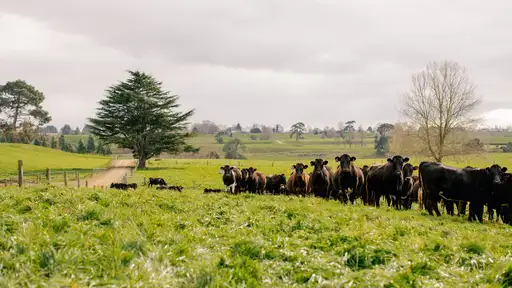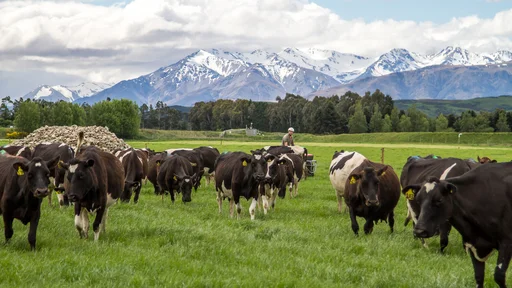Not too bad for a herd that’s been part of LIC’s Sire Proving Scheme (SPS) for 29 years.
And that’s perhaps a big part of the reason John and Pat were awarded SPS Farmers of the Year by the cooperative’s genetics experts earlier this year.
In recognition of the contribution John and Pat have made to the scheme, the pair attended LIC’s annual Breeders’ Day event in early May. 
It was a fantastic afternoon and evening,” John says, “it was a real honour to be recognised in front of the industry’s elite breeders.”
Pat agrees: “He’s so stoked to get the award. John’s very proud and the cows mean so much to him.”
“Yes, I’m excited by the award,” John says. “I can’t believe they gave it to me – I feel like I should be the one giving the award to them (SPS). I’m the one that’s benefited, I’ve gained so much over the years. Sire proving has just been part of the way I farm.”
John and Pat’s 70 hectare (effective) farm is located less than 3km from Maungaturoto, Northland, and milks a predominantly Jersey herd.
While John looks after day-to-day farm operations, Pat takes on the running of the local butchery in the heart of Maungaturoto, a business they’ve owned for several years.

John and Pat were named LIC’s SPS national Farmers of the Year because of their quality record-keeping, with information consistently provided on-time. Regular record keeping includes calving and weighing events, tagging, milking, TOP inspections, and scores for all SPS daughters. John is always a pleasure to talk with on the phone has a great sense of humour. He assists with LIC’s Alpha Catalogue with daughter photography (including taking time out to train and groom the SPS daughters), with several LIC managers recently classifying the daughters as outstanding.
Ann Scott, LIC Sire Proving Scheme manager
Ask John and Pat how they’ve managed to breed such a quality herd using LIC’s SPS semen, and John shrugs his shoulders and smiles, suggesting it’s as easy as ABC.
“To be honest all I do – and all I’ve ever done – is follow the advice I’m given by the SPS.
“I’m Mr Simple. From day one in 1986, I did what the Dairy Board (SPS) told me to do. An example is if I’m selling or getting rid of cows, I just print off the PW listing and I sell the bottom portion of my cows based on PW, and PW alone. That way I end up with the best dairy stock to milk from.”
With 100% recorded ancestry, the couple have confidence in their culling and replacement selections (John believes mis-mothering remains a big problem in non-verified herds: “As far as I’m concerned if your herd’s not DNA-verified, it’s not identified”).
“When it comes to stock I know my decisions are bang-on because there’s no parentage issues. Years back I took on the GeneMark service as soon as it was available; we used to do blood tests, but it’s much simpler now with the tissue punch.”
John admits he’s also prepared to “take a short-term hit in production” to bring through a large cohort of young replacement stock.
“There’s been times that I’ll bring through up to 30% replacements. They’re the latest genetics, and I know the time will come when they’ll hit their straps and produce better than their previous generation.”

John and Pat point out that while they don’t necessarily get to nominate their own bulls, or get access to top proven sires on the market through Premier Sires, the bull is just half the equation.
“We constantly retain the best available stock from what we know are excellent BW and PW cows, so we’re making strides that way,”
John says. “You’ve got to remember that SPS bulls are narrowed down to be among the most-promising sires out there anyway, plus we’re getting those genetics up to four years ahead of the industry, so our generation interval is squeezed way-shorter than other farmers.”
John also mates his rising two-year-olds to artificial breeding, a practice that’s been in place since he joined the scheme in 1986.
He’s also meticulous about record-keeping, a discipline he puts down to belonging to SPS.
“I herd test five times a year and I’m crazy-careful with the set-up, numbering, no double-ups, and making no mistakes. I don’t get MINDA queries. You’ve got to be systematic, and that discipline comes from sire proving.”
John also credits their success to his willingness and determination to adopt new ways of doing things, despite initial frustrations: “I’m prepared to change as I go,” John says. “I’ve got a mountain of (MINDA) yellow notebooks from the past, but I forced myself to use the M-Note when it was introduced, then the palm-held, and then MINDA Mobile. Today all I use on farm is my i-pad with the MINDA app – it’s all I need.
“It was uncomfortable for a while but I’ve got it sorted now. I can’t say I fully understand the technology but I love what it’s offered. They need to shut-down MINDApro; once they do that I’ll be forced to use MINDA LIVE all the time.”
Regional winners of LIC’s SPS Farmer of the Year:
Upper North Island: Paddy & Tash O’Shea, Morrinsville
Lower North Island: David & Catherine Smith, Hawera
Upper South Island: Andrew & Michelle Robb, Greymouth
Lower South Island: Johanna & John O’Callaghan, Invercargill




